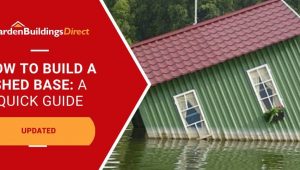Jump to:
Pressure treated wood has undergone a vacuum treatment that forces preservative chemicals deep into its cellular structure. This method is considered the best and most effective for protecting timber from fungal decay and insect infestations. Yet, whether treating lumber makes it waterproof is a more complicated answer. This guide explains why.
How Does Pressure Treatment Work?

Pressure-treating requires resources, expertise, and a lot of work. Knowing what happens behind the scenes makes it easier to see its benefits and limitations. Here’s how the magic happens: pressure treatment starts with cutting and drying the wood, then sealing it in an airtight cylinder. A vacuum pulls out the air, which cues the chemical preservatives to seep deep into the grain inside and out.
The result gives the wood a greenish tint along the grain and around knots caused by copper in the additives. This, in fact, is a great indicator that a garden building is pressure treated. Pay attention to the colour quality when shopping for a pressure treated shed, pressure treated log cabin, or pressure treated summer house—or vacuum-treated boards in general.
The next thing you know, pressure treated wood outperforms untreated varieties in durability and resistance. It becomes less appealing to termites, tough against rot, and built to keep out moisture.
Speaking of moisture, the Alkaline Copper Quaternary (ACQ) found in the preservatives is water-based—an excellent property for improving the wood’s water resistance. But does that make pressure-processed lumber waterproof?
To What Extent Is Pressure Treated Wood Waterproof?
Pressure treated wood resists moisture and decay, which helps prevent issues like condensation and rot. However, it’s not completely waterproof. The treatment helps repel water but is not strong enough to make the wood fully resistant.
Sure, it can withstand dribbling water on its surface or a quick rinse from a hose for maintenance, but exposure to high humidity and prolonged rain is a different matter.
For instance, a pressure treated shed in contact with pooling water underneath may trigger fungal decay, leading to mould growth and rot. And don’t ever think about submerging decking or fencing boards. Wood is a natural material with cellular structures that can hold water, and the pressure treatment can break if left exposed to water, let alone covered by it, for long periods.
In conclusion: while the pressure treatment helps protect your wooden building from the effects of normal wet conditions in a garden, that doesn’t mean you can soak it through and let it stay wet.
Does Painting Pressure Treated Wood Help?
Yes, painting does help! A water-based paint, in particular, adheres well to treated wood. It adds an extra layer of protective barrier on top of the treatment and keeps moisture at bay from penetrating the lumber. What we like about good quality paint is that it extends its protection to UV rays, rain, and snow. On top of that, the right hue can cover the unsightly greenish tinge into something more fitting to your garden setup.
However, pressure-treated lumber must dry out before you can paint it. This process takes about 3 to 4 months or longer during winter, up to 6 months, before the moisture levels drop. So, if you’ve picked up a few treated lumber pieces from the hardware store. Just let the wood be and wait for it to cure.
Tip: Give the wood a moisture test by sprinkling water on the surface after letting it sit. If it soaks in, it’s ready for coating. If the water beads up, it needs more time.
Read our guide, ‘Can I Paint Pressure Treated Wood?’, for more information.
Round-up
Is pressure treated wood waterproof? Yes, because the treatment does the job of making it more resistant to moisture and decay than untreated wood. And no, because that doesn’t mean it’s 100% waterproof against long-term exposure.
Water-based paint can help improve water resistance after the pressure treatment has fully dried. You can also always go right with a constant upkeep and ensure the treatment is still intact. Raising off the ground is a smart move, too, to reduce direct contact with water. And please keep the treated lumber out of standing water.
Pressure-treated wood has a strong start, but it won’t last forever. However, with a keen eye and regular maintenance, you can prolong its lifespan and help it resist water!
Up next on your reading list: Pressure Treated vs Dip Treated Wooden Buildings





